FORD FOCUS 2015 3.G ST Supplement Manual
Manufacturer: FORD, Model Year: 2015, Model line: FOCUS, Model: FORD FOCUS 2015 3.GPages: 34, PDF Size: 2.41 MB
Page 11 of 34
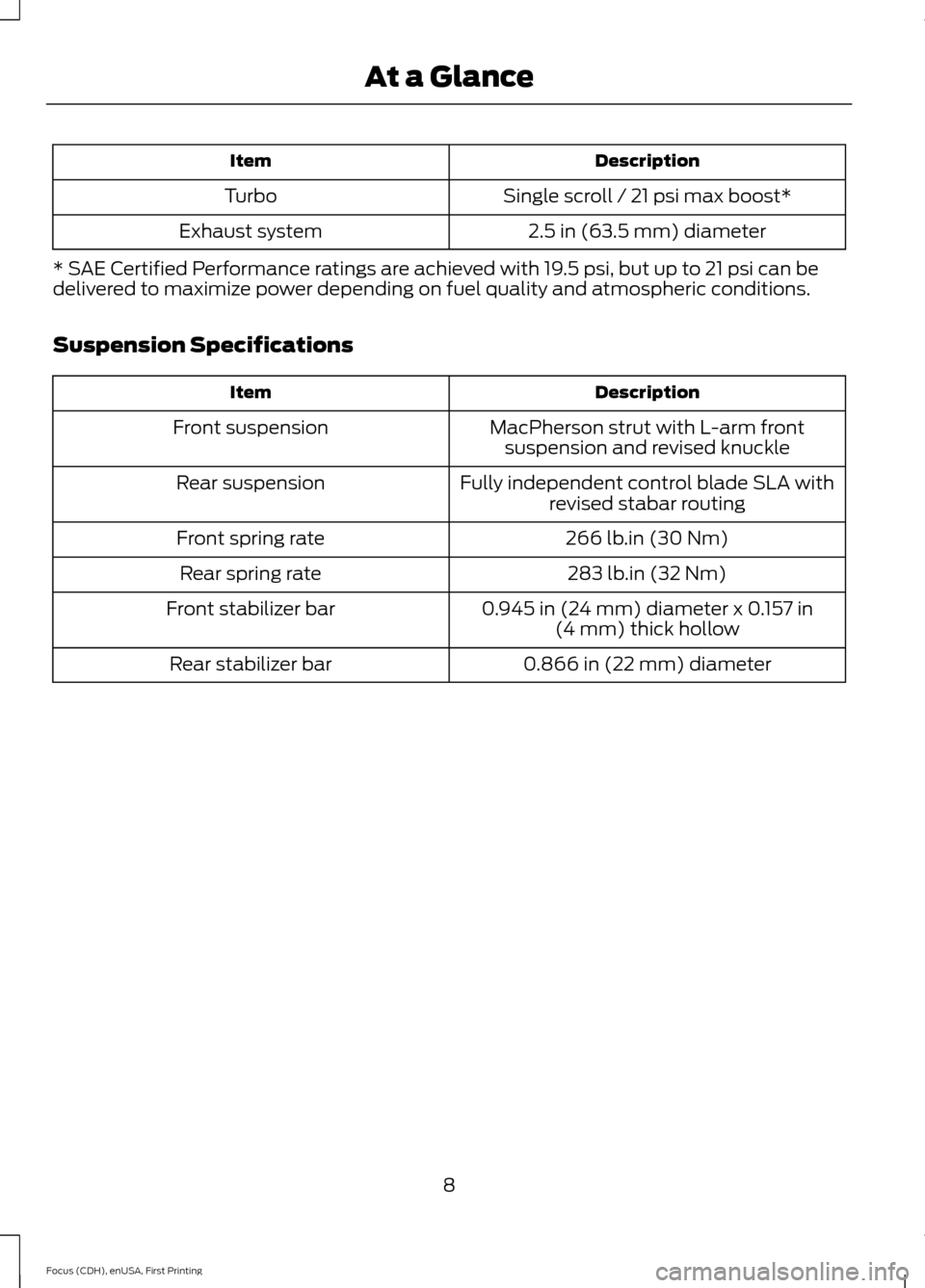
DescriptionItem
Single scroll / 21 psi max boost*Turbo
2.5 in (63.5 mm) diameterExhaust system
* SAE Certified Performance ratings are achieved with 19.5 psi, but up to 21 psi can bedelivered to maximize power depending on fuel quality and atmospheric conditions.
Suspension Specifications
DescriptionItem
MacPherson strut with L-arm frontsuspension and revised knuckleFront suspension
Fully independent control blade SLA withrevised stabar routingRear suspension
266 lb.in (30 Nm)Front spring rate
283 lb.in (32 Nm)Rear spring rate
0.945 in (24 mm) diameter x 0.157 in(4 mm) thick hollowFront stabilizer bar
0.866 in (22 mm) diameterRear stabilizer bar
8Focus (CDH), enUSA, First PrintingAt a Glance
Page 12 of 34
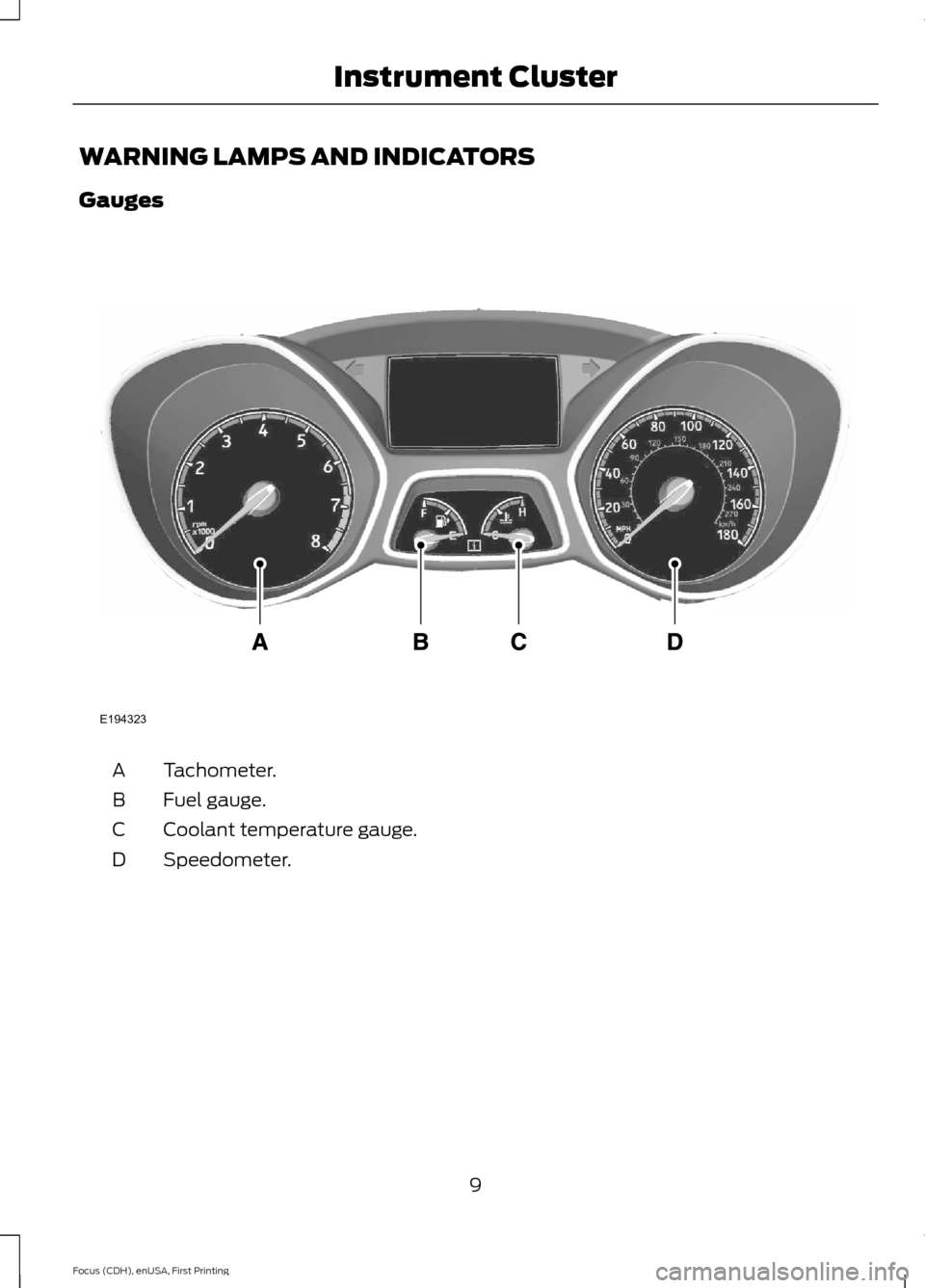
WARNING LAMPS AND INDICATORS
Gauges
Tachometer.A
Fuel gauge.B
Coolant temperature gauge.C
Speedometer.D
9Focus (CDH), enUSA, First PrintingInstrument ClusterE194323
Page 13 of 34
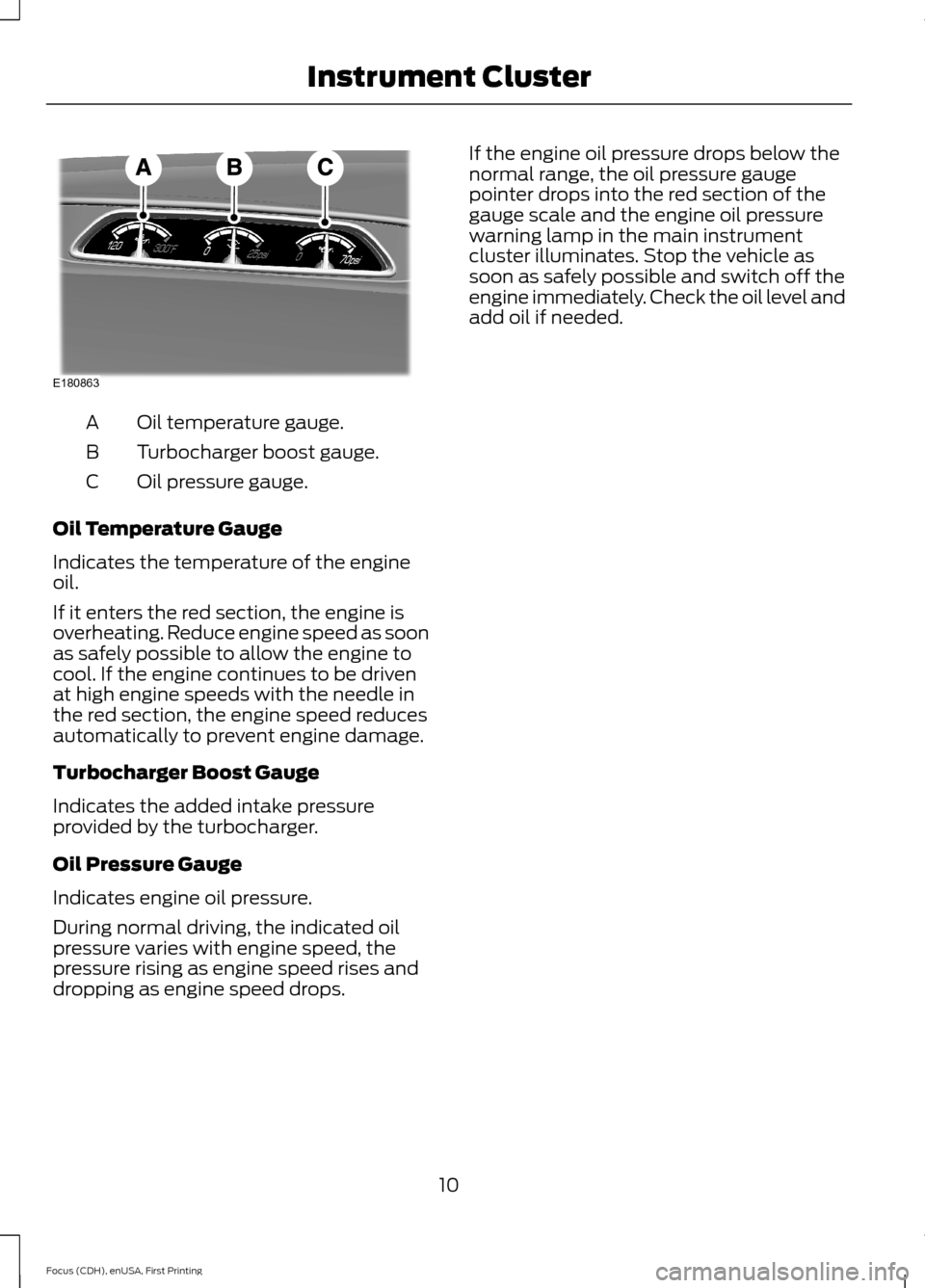
Oil temperature gauge.A
Turbocharger boost gauge.B
Oil pressure gauge.C
Oil Temperature Gauge
Indicates the temperature of the engineoil.
If it enters the red section, the engine isoverheating. Reduce engine speed as soonas safely possible to allow the engine tocool. If the engine continues to be drivenat high engine speeds with the needle inthe red section, the engine speed reducesautomatically to prevent engine damage.
Turbocharger Boost Gauge
Indicates the added intake pressureprovided by the turbocharger.
Oil Pressure Gauge
Indicates engine oil pressure.
During normal driving, the indicated oilpressure varies with engine speed, thepressure rising as engine speed rises anddropping as engine speed drops.
If the engine oil pressure drops below thenormal range, the oil pressure gaugepointer drops into the red section of thegauge scale and the engine oil pressurewarning lamp in the main instrumentcluster illuminates. Stop the vehicle assoon as safely possible and switch off theengine immediately. Check the oil level andadd oil if needed.
10Focus (CDH), enUSA, First PrintingInstrument ClusterE180863
Page 14 of 34
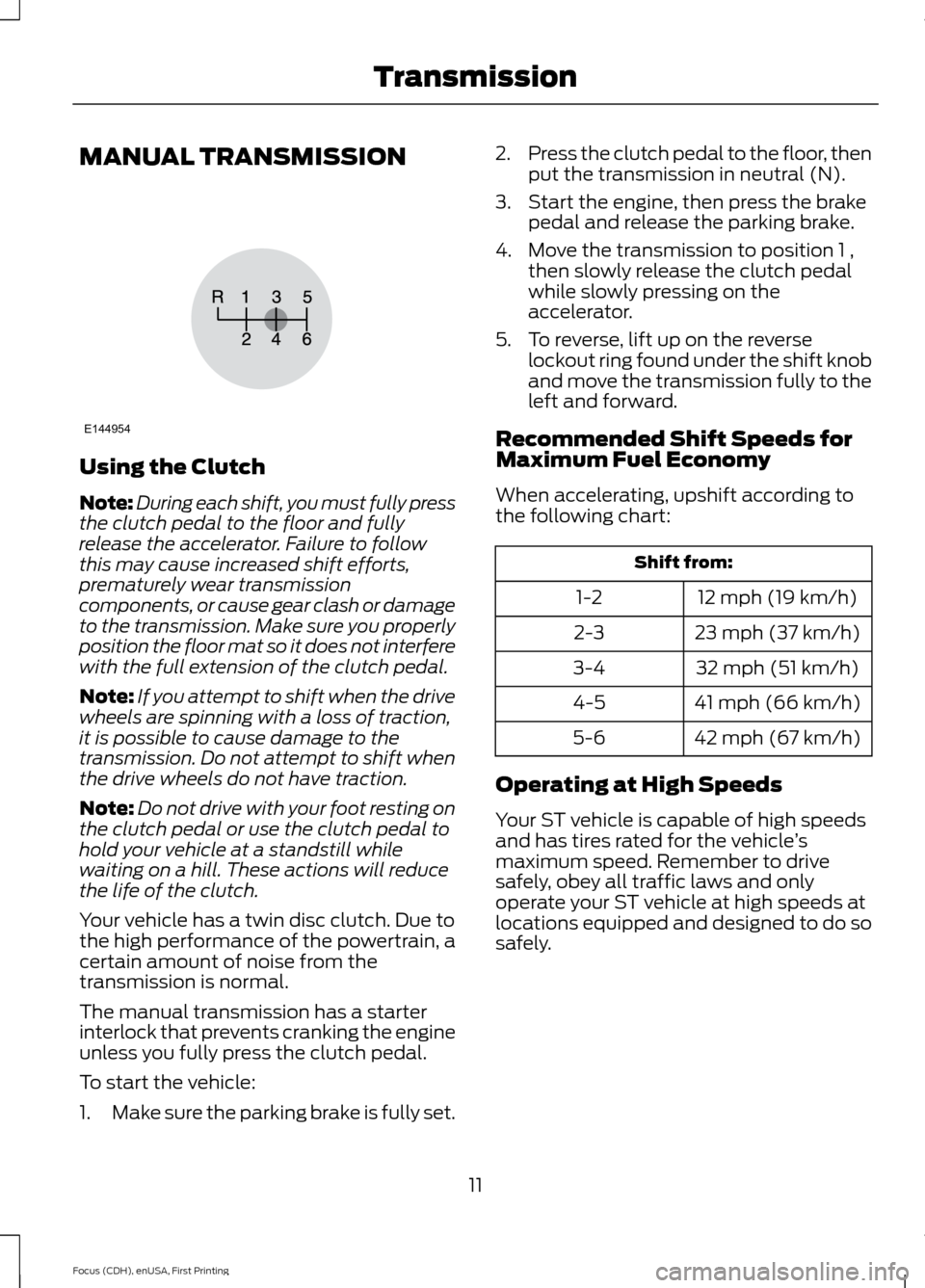
MANUAL TRANSMISSION
Using the Clutch
Note:During each shift, you must fully pressthe clutch pedal to the floor and fullyrelease the accelerator. Failure to followthis may cause increased shift efforts,prematurely wear transmissioncomponents, or cause gear clash or damageto the transmission. Make sure you properlyposition the floor mat so it does not interferewith the full extension of the clutch pedal.
Note:If you attempt to shift when the drivewheels are spinning with a loss of traction,it is possible to cause damage to thetransmission. Do not attempt to shift whenthe drive wheels do not have traction.
Note:Do not drive with your foot resting onthe clutch pedal or use the clutch pedal tohold your vehicle at a standstill whilewaiting on a hill. These actions will reducethe life of the clutch.
Your vehicle has a twin disc clutch. Due tothe high performance of the powertrain, acertain amount of noise from thetransmission is normal.
The manual transmission has a starterinterlock that prevents cranking the engineunless you fully press the clutch pedal.
To start the vehicle:
1.Make sure the parking brake is fully set.
2.Press the clutch pedal to the floor, thenput the transmission in neutral (N).
3.Start the engine, then press the brakepedal and release the parking brake.
4.Move the transmission to position 1 ,then slowly release the clutch pedalwhile slowly pressing on theaccelerator.
5.To reverse, lift up on the reverselockout ring found under the shift knoband move the transmission fully to theleft and forward.
Recommended Shift Speeds forMaximum Fuel Economy
When accelerating, upshift according tothe following chart:
Shift from:
12 mph (19 km/h)1-2
23 mph (37 km/h)2-3
32 mph (51 km/h)3-4
41 mph (66 km/h)4-5
42 mph (67 km/h)5-6
Operating at High Speeds
Your ST vehicle is capable of high speedsand has tires rated for the vehicle’smaximum speed. Remember to drivesafely, obey all traffic laws and onlyoperate your ST vehicle at high speeds atlocations equipped and designed to do sosafely.
11Focus (CDH), enUSA, First PrintingTransmissionE144954
Page 15 of 34
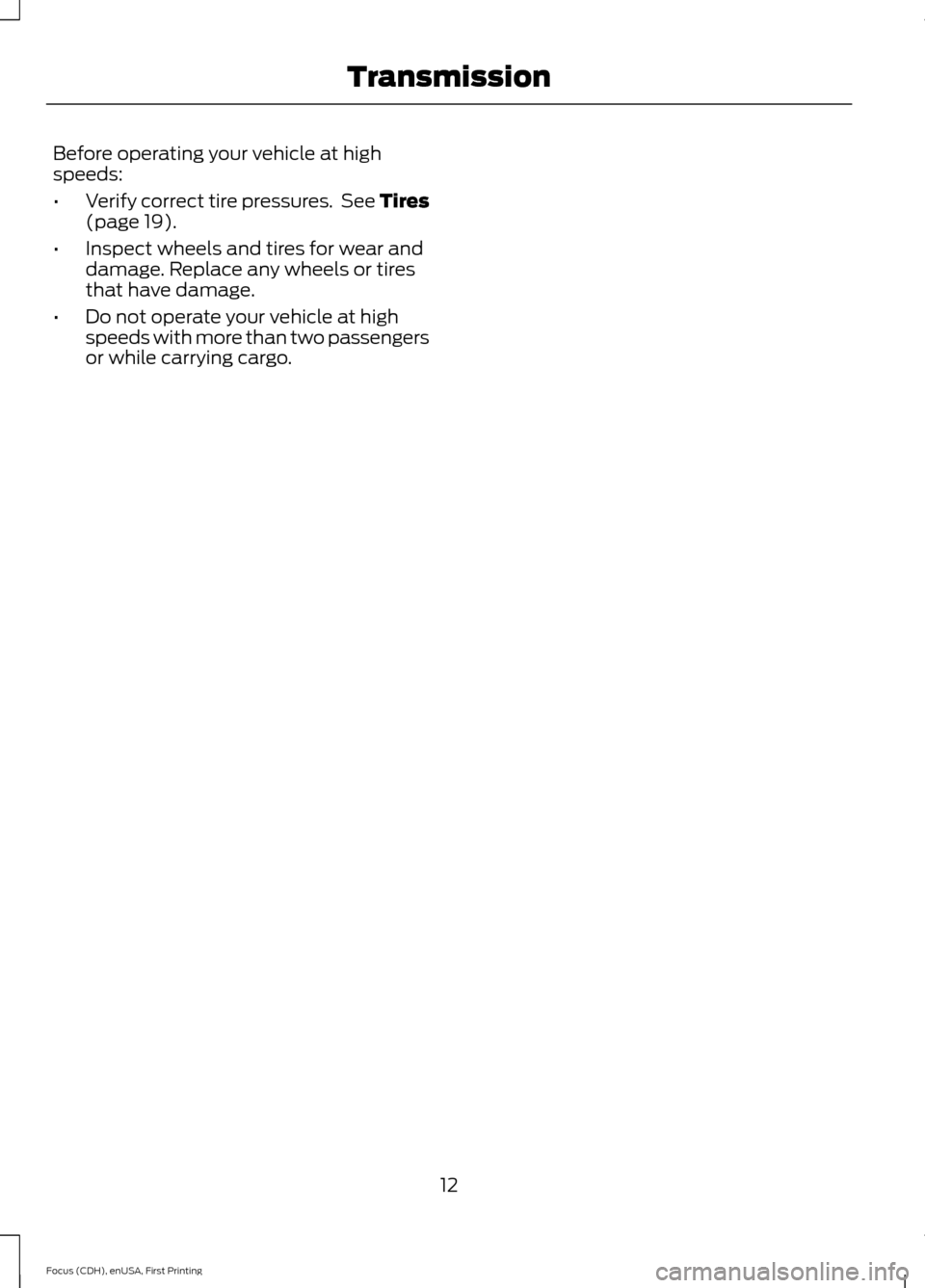
Before operating your vehicle at highspeeds:
•Verify correct tire pressures. See Tires(page 19).
•Inspect wheels and tires for wear anddamage. Replace any wheels or tiresthat have damage.
•Do not operate your vehicle at highspeeds with more than two passengersor while carrying cargo.
12Focus (CDH), enUSA, First PrintingTransmission
Page 16 of 34
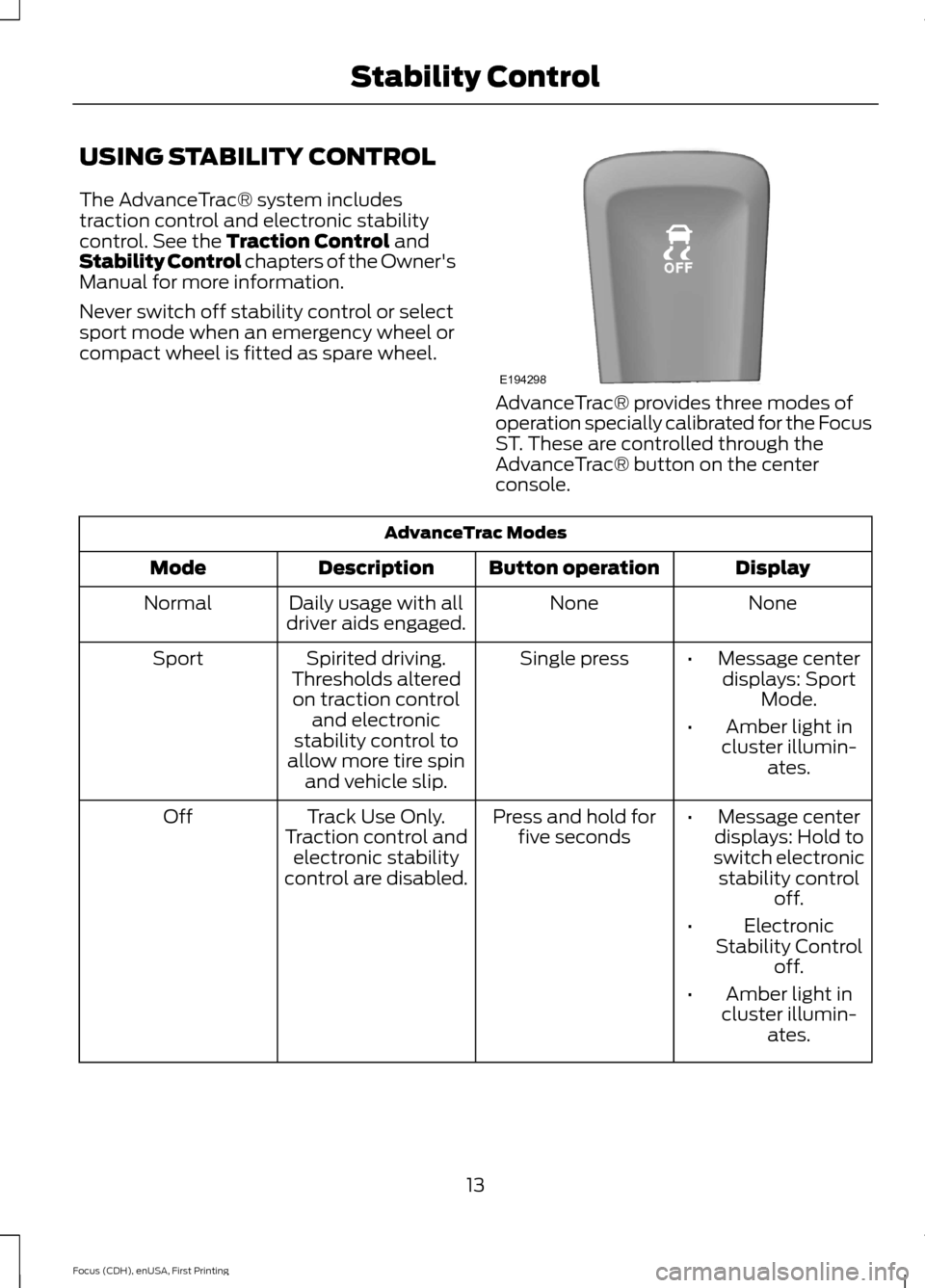
USING STABILITY CONTROL
The AdvanceTrac® system includestraction control and electronic stabilitycontrol. See the Traction Control andStability Control chapters of the Owner'sManual for more information.
Never switch off stability control or selectsport mode when an emergency wheel orcompact wheel is fitted as spare wheel.
AdvanceTrac® provides three modes ofoperation specially calibrated for the FocusST. These are controlled through theAdvanceTrac® button on the centerconsole.
AdvanceTrac Modes
DisplayButton operationDescriptionMode
NoneNoneDaily usage with alldriver aids engaged.Normal
•Message centerdisplays: SportMode.
•Amber light incluster illumin-ates.
Single pressSpirited driving.Thresholds alteredon traction controland electronicstability control toallow more tire spinand vehicle slip.
Sport
Press and hold forfive secondsTrack Use Only.Traction control andelectronic stabilitycontrol are disabled.
Off•Message centerdisplays: Hold toswitch electronicstability controloff.
•ElectronicStability Controloff.
•Amber light incluster illumin-ates.
13Focus (CDH), enUSA, First PrintingStability ControlE194298
Page 17 of 34
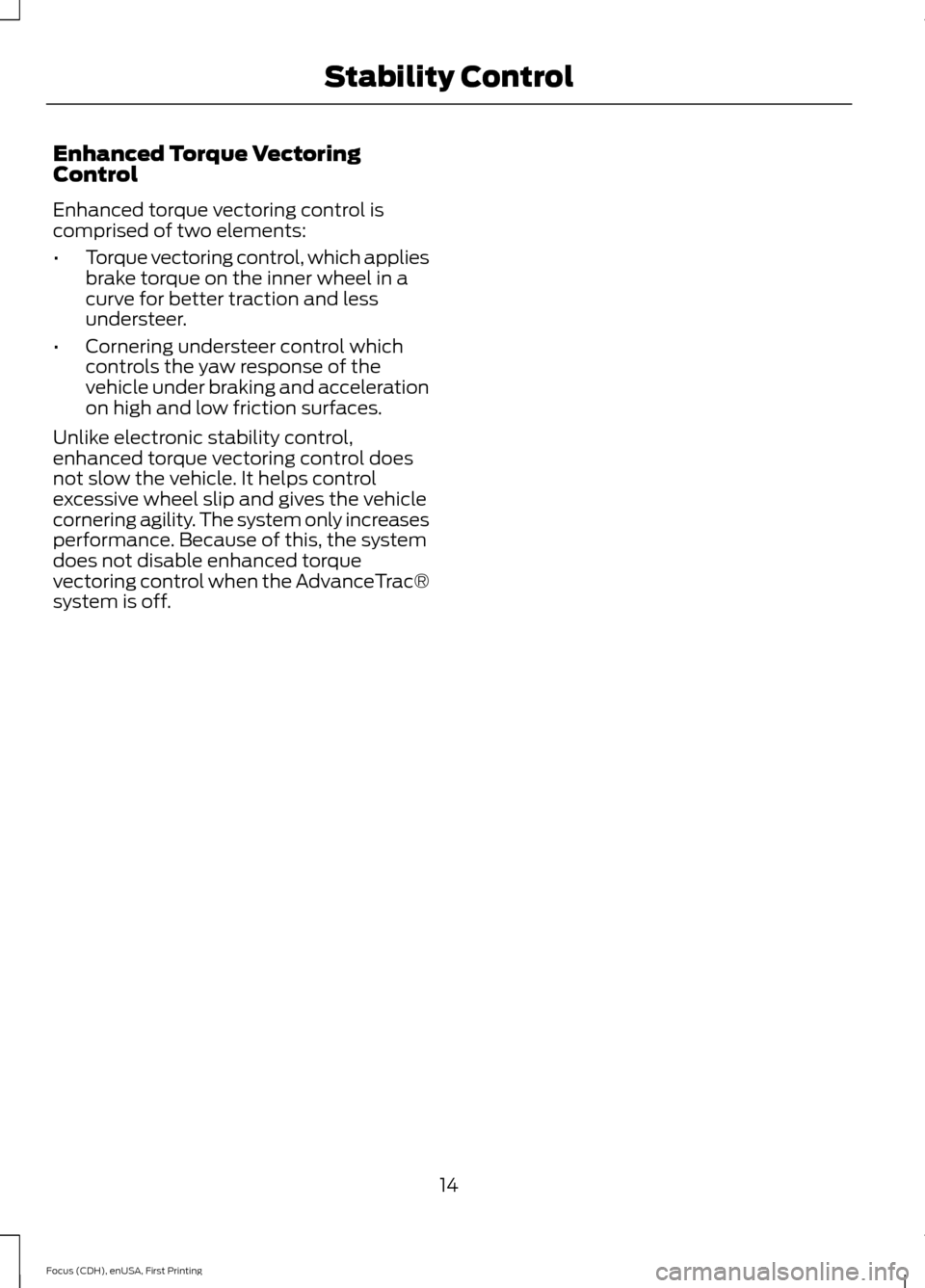
Enhanced Torque VectoringControl
Enhanced torque vectoring control iscomprised of two elements:
•Torque vectoring control, which appliesbrake torque on the inner wheel in acurve for better traction and lessundersteer.
•Cornering understeer control whichcontrols the yaw response of thevehicle under braking and accelerationon high and low friction surfaces.
Unlike electronic stability control,enhanced torque vectoring control doesnot slow the vehicle. It helps controlexcessive wheel slip and gives the vehiclecornering agility. The system only increasesperformance. Because of this, the systemdoes not disable enhanced torquevectoring control when the AdvanceTrac®system is off.
14Focus (CDH), enUSA, First PrintingStability Control
Page 18 of 34
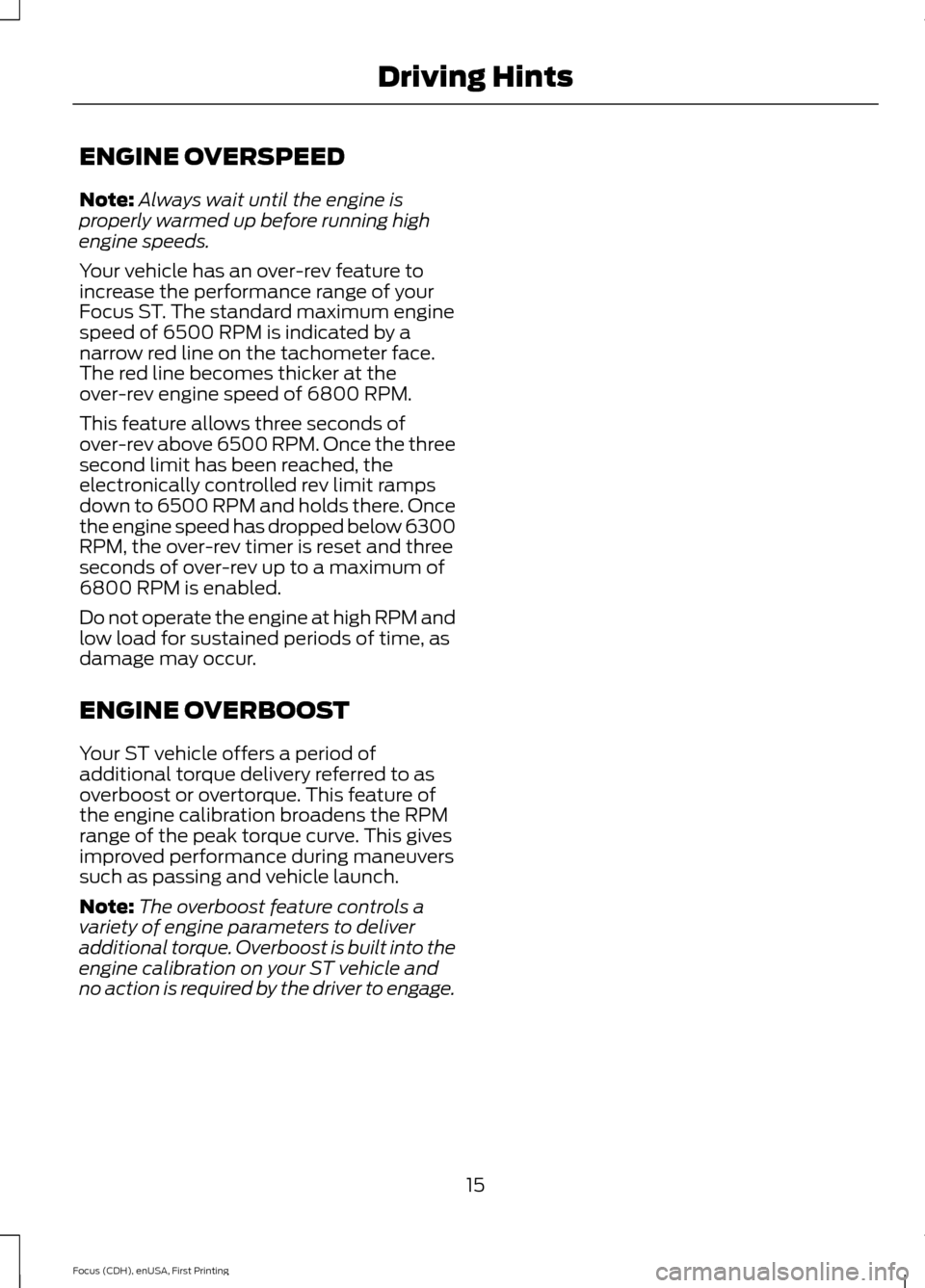
ENGINE OVERSPEED
Note:Always wait until the engine isproperly warmed up before running highengine speeds.
Your vehicle has an over-rev feature toincrease the performance range of yourFocus ST. The standard maximum enginespeed of 6500 RPM is indicated by anarrow red line on the tachometer face.The red line becomes thicker at theover-rev engine speed of 6800 RPM.
This feature allows three seconds ofover-rev above 6500 RPM. Once the threesecond limit has been reached, theelectronically controlled rev limit rampsdown to 6500 RPM and holds there. Oncethe engine speed has dropped below 6300RPM, the over-rev timer is reset and threeseconds of over-rev up to a maximum of6800 RPM is enabled.
Do not operate the engine at high RPM andlow load for sustained periods of time, asdamage may occur.
ENGINE OVERBOOST
Your ST vehicle offers a period ofadditional torque delivery referred to asoverboost or overtorque. This feature ofthe engine calibration broadens the RPMrange of the peak torque curve. This givesimproved performance during maneuverssuch as passing and vehicle launch.
Note:The overboost feature controls avariety of engine parameters to deliveradditional torque. Overboost is built into theengine calibration on your ST vehicle andno action is required by the driver to engage.
15Focus (CDH), enUSA, First PrintingDriving Hints
Page 19 of 34
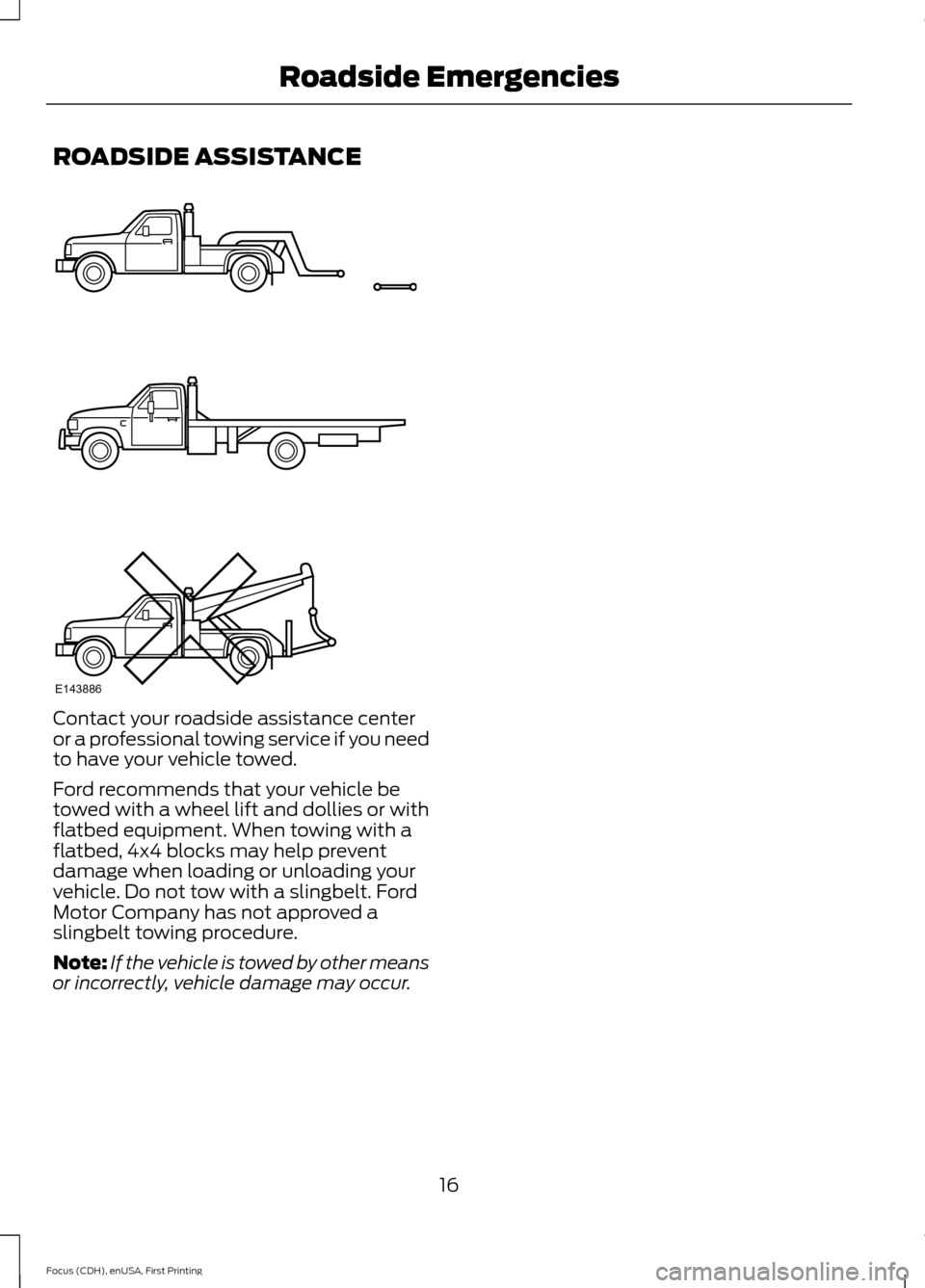
ROADSIDE ASSISTANCE
Contact your roadside assistance centeror a professional towing service if you needto have your vehicle towed.
Ford recommends that your vehicle betowed with a wheel lift and dollies or withflatbed equipment. When towing with aflatbed, 4x4 blocks may help preventdamage when loading or unloading yourvehicle. Do not tow with a slingbelt. FordMotor Company has not approved aslingbelt towing procedure.
Note:If the vehicle is towed by other meansor incorrectly, vehicle damage may occur.
16Focus (CDH), enUSA, First PrintingRoadside EmergenciesE143886
Page 20 of 34
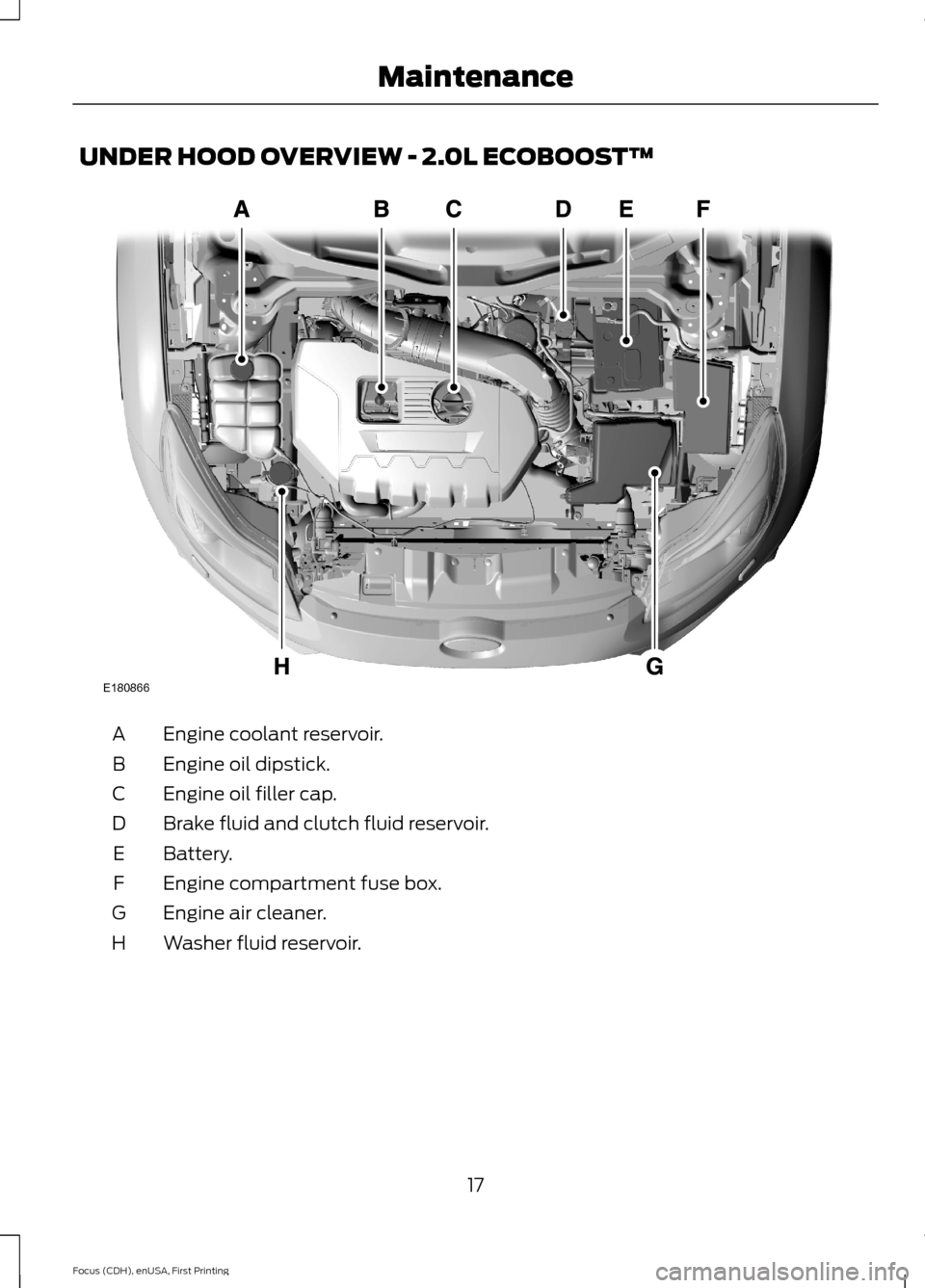
UNDER HOOD OVERVIEW - 2.0L ECOBOOST™
Engine coolant reservoir.A
Engine oil dipstick.B
Engine oil filler cap.C
Brake fluid and clutch fluid reservoir.D
Battery.E
Engine compartment fuse box.F
Engine air cleaner.G
Washer fluid reservoir.H
17Focus (CDH), enUSA, First PrintingMaintenanceE180866